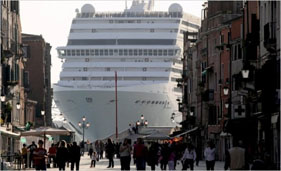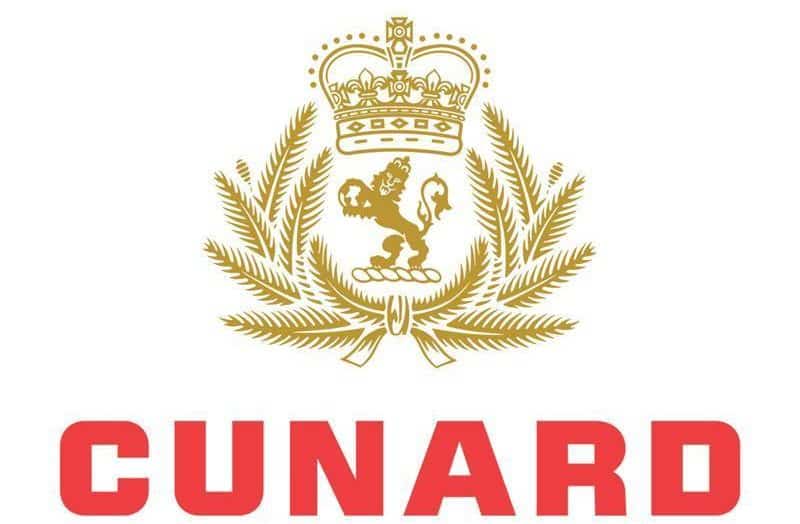Venice revolts against tourism

All over the world our global heritage is under assault by disrespectful tourist hordes. From Vietnam to Venice the goose that lays the golden egg of profit for the travel industry is slowly being bled to death.
But in Venice the fight back has begun. The citizens of La Serenissima, possibly the world’s most iconic tourism destination, are finally revolting against tourists.
In August the city of Venice, says the Venice Times, "will receive a real mass tourism ‘assault’. Visitors will sit on the steps of the century-old buildings and bridges, eating, trashing and not showing the respect these buildings deserve."
"Walking on the small narrow streets without left and right side order, like in other cities, making the traffic impossible to stand, offering a truly claustrophobic experience."
There are those who are not afraid to say that something MUST be done. Ilaria Borletti Buitoni former president of the Fai, an Italian Environment Fund believes that there must be some type of tourist access control in Venice. "I know that I will draw negative comments by saying this, but Venice is an open-air museum and the city is dying. The mass of tourists in the city is expected to increase to unbearable amounts in the coming years. The idea of establishing an admission ticket to the city for its maintenance should be considered. It will protect the city and improve the quality of tourism."
According to a recent survey by the local newspaper La Nuova, 66% of its readers agree that there must be some type of restriction to Venice and only 12% believe that there should be no restriction since the city belongs to the World.

And who can blame them? Each day, more than 60,000 people visit Venice – more than the entire population of the city. Of those, an increasing number are from cruise ships; with a 439 percent increase in cruise dockings in the past 15 years, according to statistics from the Venice Passenger Terminal.
It is feared that the sheer number of visitors are damaging the city, part of whose economy is based around them.
"Tourism is a double-edged sword," said Peter Debrine, head of the World Heritage and Sustainable Tourism Programme at UNESCO, "You can’t have those kind of numbers come into a site and not have a negative impact."
Residents are now asking what they get out of this obscene parody of tourism. The answer is very little. As the tourism inflows are driven by the likes of big global corporations, they want to spend the least and get the most out of the tourist attraction they get for free.
When vast numbers of tourists arrive by cruise ship, it’s the cruise companies who have first call on their passenger’s wallets. The tourists eat on board, buy high-priced excursions from the purser and spend little with local businesses.
And who can blame the tourists? Their facilitator and companion is the cruise company who tend to be more interested in their own survival than that of their destinations. So In the cruel price war of the last few years the casualties have been fabulous ports like Venice. Cruise companies desperately need their excursion profits to survive so their passengers get to be ring-fenced, wallet-toting hostages.
But Venice is a fantastic draw – hence more and more massive ships, more and more tourists, and shrinking benefits to locals.
Maybe Venice, and other high-level world heritage destinations, should charge hefty entrance fees?
The story is the same everywhere. Wherever the stakes are high – and they are particularly high in UNESCO destinations – big global players sweep the board using massed tourists as their forces and destination populations as their collateral damage.
Cruise ships or busses, it’s the same game.
Mass tourism has always presented a threat to sensitive destinations – even back in the ’90’s when there were 500 million international tourists a year. But now the figure has doubled – and it’s growing yet again, plus new source markets such as China are throwing their weight into the game.

And this despoilment is palpable: just go to St Mark’s Square in Venice, the Duomo in Florence, the Abbey Churchyard in Bath or Damrak in Amsterdam (amongst thousands of other delicate destinations) and you will see a sight that is unappetizing at best – crowds of tired, disinterested, dazed tourists.
Now even voices are raised in emerging destinations such as Vietnam where not only tangible cultural heritage is at risk . To Ngoc Thanh, chairman of the Viet Nam Folk Arts Association, said he is upset when don ca tai tu (talented instrumental music and singing), an accepted part of UNESCO’s Intangible Cultural Heritage of Humanity, is performed to entertain tourists while they eat.
As tour timetables are so tight, tour managers often arrange for tourists to enjoy the performance during the meal. While talented instrumentalists and songstresses perform and try to introduce the beauty of their world-recognised heritage, tourists eat and talk to each other.
Thanh said most audiences did not realise the beauty of the music and certainly did not understand the meaning of the lyrics.
"I feel unhappy when such fine music is performed at restaurants and the talented musicians received a trifle from restaurants’ owners and travel companies," said Thanh. Adding that people often exploited heritage to serve tourism, but ignored or did not really understand its quintessential meaning.

Even Amsterdammers are joining in protest, writes the Director General of the Rijksmuseum, Wim Pijbes – calling for a ‘Delta Plan Amsterdam Tourist’ "Anyone who daily visits our city, sees the limits of growth in recent years – the litter, the irritations, the rows, ambulatory street trading, illegal short-stay accommodation – Amsterdam is dirty, filthy and full."
And who benefits from all this extractive, disrespectful activity?
Tourists pay big bucks to the tour operators and get a debased, superficial product in return (there are reports of Chinese tourists locking themselves in their hotel rooms in Paris because they are so upset that the Paris of their dreams is nowhere the same in reality).
Destinations host millions of tourists, and their real masters – their voting local stakeholders – get thrown crumbs in return: low grade jobs in return for not being able to enjoy their own hometown.
Tour operators and cruise companies, on the other hand, have a completely free ride – without any skin in the destination game, they are able to use the destinations massive marketing power, free, to fill their own bank accounts.
And it’s not a fair match. Tourism officials are generally low-grade administrators – how can they possibly square up to highly paid, globally experienced top executives of travel multinationals?
That’s why they almost always lose hands down – with a few exceptions.
It is time for destinations to come to the plate, recognize the true value of their tourism brands and see them in the same way as those who are draining their value. In this way they can take control and manage them for profit; that is, the local stakeholders’ profit, which is more likely to be sustainable profit.
With key destinations like Venice, Paris and Amsterdam buckling under the sheer weight of tourist numbers, something has to be done, or everyone – from multinational cruise companies to local people – will lose the use of tourism’s golden goose.
Valere Tjolle
@ValereTjolle
 United Kingdom
United Kingdom United States
United States Asia Pacific
Asia Pacific












































Dozens fall ill in P&O Cruises ship outbreak
Turkish Airlines flight in emergency landing after pilot dies
Boy falls to death on cruise ship
Unexpected wave rocks cruise ship
Storm Lilian travel chaos as bank holiday flights cancelled